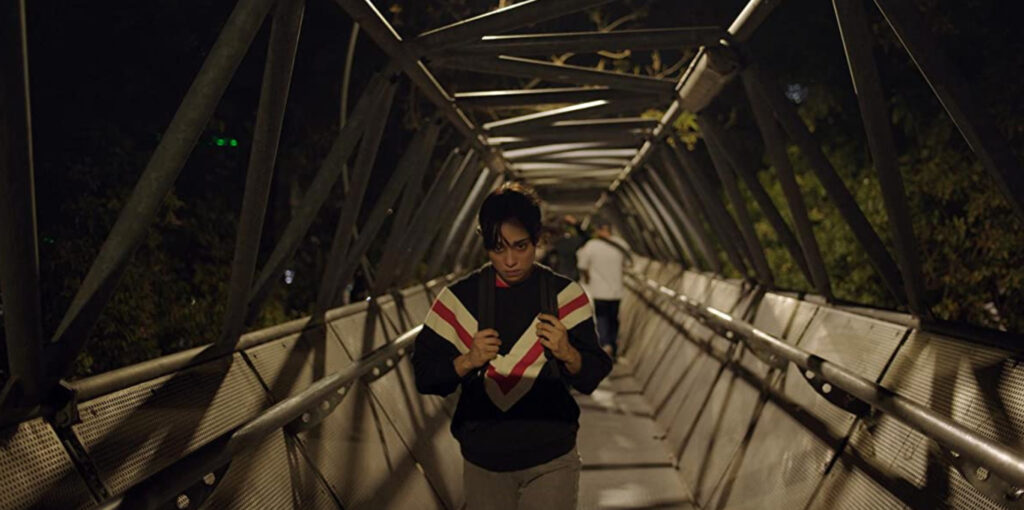“Huesera: The Bone Woman” Cracks Longstanding Myths About Motherhood

Michelle Garza Cervera’s Huesera: The Bone Woman is not the first horror movie to deal with pregnancy. Many filmmakers have explored the unique body horror involved in first growing then giving birth to a child, but what often goes unsaid is the mental toll starting a family can take on a new parent. Huesera: The Bone Woman explores the horrors of looming motherhood with a unique monster that effectively captures this life-changing experience. Motherhood causes a cavalcade of physical and mental changes and the experience of being thrust into this transition can often feel like a nightmare. Cervera’s breathtaking film explores these visceral changes in a unique way that allows us to honestly reassess a process we’ve been trained to believe is a joyful miracle.
Valeria (Natalia Solián) is a young furniture designer and newlywed trying to get pregnant. When she and her husband Raúl (Alfonso Dosal) learn that they will soon be parents, they are seemingly overjoyed. But a lurking shadow falls over their happiness. Valeria has caught the attention of a mysterious woman with bones that crack and grind with each movement of her disjointed body. Lurking in the shadows, she grows closer and closer to the mother-to-be, threatening not only the life she’s carefully built but the survival of her newborn child. With nowhere else to turn, Valeria seeks help from a coven of witches to rid her of this looming specter of death. Once Valeria begins their ritual there is no going back and the cure may leave her seemingly happy life in shambles.
Huesera: The Bone Woman explores the horrific elements of pregnancy and the mentality of preparing for birth with a terrifying creature that perfectly embodies this brutal phase of life. Valeria first spots her staring from across a courtyard. She falls out the third story window and crashes to the ground below, beginning a painful transition that will mirror Valeria’s own journey to motherhood. Though pregnancy can be joyful and exciting, the constant bodily changes can often feel horrifying, like being trapped in a body that no longer feels like your own. In addition to this upsetting shadow, Valeria’s hands seem unable to stop cracking themselves, twisting and snapping the bones painfully in a nervous gesture that telegraphs her growing unease.
Once the baby is here, Valeria has another relatable experience. She suffers from postpartum depression and has difficulty connecting with her child. The lurking woman takes on frightening new implications as Valeria struggles to take care of an infant when she can barely take care of herself. As the creature draws closer, Valeria’s discomfort with motherhood grows. A scene in which she becomes possessed by this mysterious woman and loses track of her identity is both horrifying in its deadly implications and a painful representation of how new motherhood can feel.
Valeria doesn’t have an especially difficult pregnancy, but she’s plagued by doubts about her fitness as a mother. It’s a relatable fear likely shared by anyone who’s ever parented a child, but one that we rarely feel comfortable expressing. In Valeria’s case these fairly commonplace anxieties are exacerbated by her particularly unsupportive family. Though Huesera: The Bone Woman is a supernatural horror film, one of the more horrific elements of the story is how she is constantly shamed for minor mistakes and repeatedly told that she is in over her head. Flashbacks reveal that Valeria has spent a large part of her life trying to please a family who will never accept her. She begins to take refuge with her old friend Octavia (Mayra Batalla) and the true meaning of the Bone Woman begins to take shape. She is both a manifestation of the rapid bodily changes Valeria is experiencing, but also of her painful attempts to twist herself into the kind of woman she believes everyone wants her to be. While she does love her baby, it seems that every step towards motherhood takes her further away from her authentic self.
Once the bone woman gets inside Valeria she has no choice but to turn to a coven of witches for help. She’s been warned that once she begins this transformation, there’s no going back, but at the end of her rope, she has no choice. These witches begin a ritual spell that is truly horrific, but necessary to free Valeria from a life she doesn’t want. Shifting to a more metaphysical narrative, Valeria must go through the painful process of undoing the Bone Woman’s monstrous design. This striking imagery feels both brutal and cathartic, a fitting end to a horrific nightmare.
Cervera’s film is not only an effective ghost story with a unique creature at its heart, but a brutally honest exploration of conflicted motherhood and the pressures women often feel to be perfect. We twist ourselves in knots to please everyone else and it’s easy to lose track of who we are. Huesera: The Bone Woman beautifully captures the terror and pain of one of life’s greatest transitions and dares us to decide for ourselves who we want to be.
Jenn Adams is a writer, podcaster, and film critic from Nashville, TN. Find her social media nonsense @jennferatu.